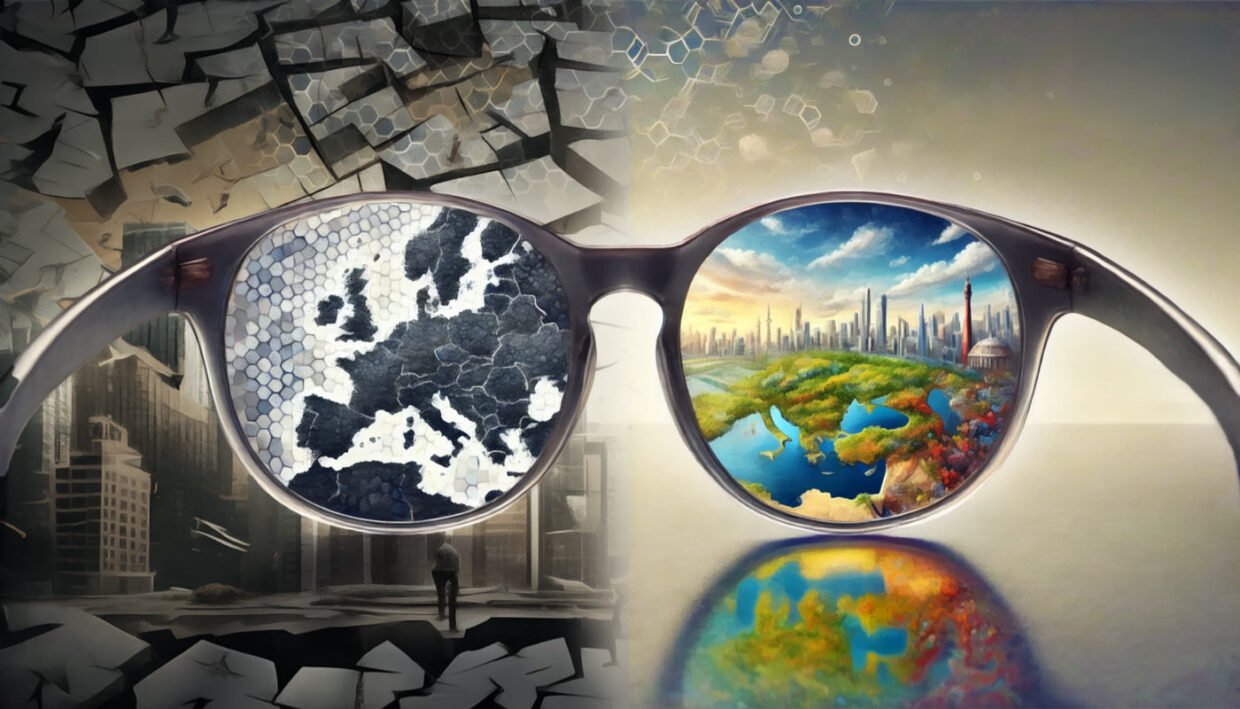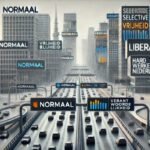
- arrow_back Home
- keyboard_arrow_right The Exploration
A new take on economics: “Change the way you look, and what you see changes”

The Exploration Jeroen Schepens 16 March 2025
Wayne W. Dyer was not an economist or political thinker, but a psychologist and writer who became known in the 1970s and 1980s for his books on personal growth. He spearheaded the popular self-help movement, but his work was less woolly than much of what would later fall under that rubric. His message was simple: the way you experience the world is largely determined by how you look at it.
This is not a spiritual cry, but a sober observation.
Dyer’s most famous statement – “Change the way you look at things, and the things you look at change” – stems from a psychological principle that has been studied for decades. Our brain is not a neutral observer, but a pattern recognizer. What we see is unconsciously colored by our expectations, our beliefs and the stories we are told about the world.
Take optical illusions, for example. Two people can look at the same image and see completely different things, simply because their brains make different interpretations. But it goes far beyond visual tricks. This mechanism determines how a new view of economics changes our understanding, how politics functions and how we see society.
Look around you and you see a stream of unconnected events. An economic crisis here, a political scandal there. Yet another hospital closing, a company “efficiently reorganizing” – as if they were all random incidents.
But what if that crisis is not a fault in the system, but the system itself? Suppose it is not about “individual problems,” but about the way everything is connected?
Why we see the world in fragments
We need a new perspective on economics to better understand economics and politics. Too often we see it as simple choices, but the reality is more complex. Are you for or against capitalism? Left or right? More market or more government? But reality is not so easily captured.
Without a new view of economics, capitalism often remains an all-or-nothing story. Things can also be different, I described in the story about capitalism in historical perspective. For example, capitalism in the 1950s, in which wages rose most with productivity, was fundamentally different from capitalism today, in which corporations make record profits while workers barely get ahead. The problem is not “capitalism” as a concept, but how the rules of the game have been rewritten over time.
Politics seems to be a battle between extremes – the left wants more government, the right wants less. But that opposition masks a deeper pattern. While we continue to debate “the market” versus “the state,” the real power remains where it has always been: with those who write the rules.
And there’s another thing.
The way we learn to see the world is not just shaped by political campaigns or economic models. The news, in newspapers and on TV, serves up reality as if it consists of a succession of incidents. Every day a new crisis, a scandal, an outrage. Attention goes to the puppets-the villains, the victims, the moral condemnations-but rarely to the structure behind it.
An allowance affair? Shame! That big corporation evading taxes? Reprehensible! A pension system that creates more and more uncertainty? Tragic!
However, it always sticks to the symptoms. Rarely is the question asked why things keep going this way. Why the patterns repeat themselves. And why the power structures that make these outcomes possible are never really questioned.
As long as we remain fixated on the delusion of the day, we miss how the game is really played.
The moment when everything falls together
Often you don’t see the pattern until you step back. Suddenly you get a grip on what seemed elusive before.
We always talk about “the economy” as if it were a force of nature-something that fluctuates, grows or collapses, depending on circumstances. But economics is not a weather report. It is choices. Rules of the game. And those rules don’t happen to be set up so that a small group always wins and the rest have to constantly work harder to stay in the same place.
We talk about a democracy in which the voter decides, but time and again the same interests surface. Not because politicians conspire en masse, but because the structures in which they operate are built in such a way that there is hardly any room for real change.
The patterns are in front of you, but you don’t see them until you know what to look for.
Why does every crisis feel like an inevitability? Why is it that the solution to economic problems often actually increases inequality rather than decreases it? Why must wages remain moderate “for competitiveness” while shareholders pay out record profits?
The answer is simple: The system is not broken. It is doing exactly what it was built to do. But if that’s true, it also means it can be done differently. So the question is not, “how do we fix the old model?” . The question is, “what do we build in its place?”
This is just the beginning
If you’re expecting a conclusion now, you haven’t been paying attention. This is not a conclusion – this is a tipping point.
We have peeled off the first layers, let go of the superficial explanations. But the core is still before us. In the coming weeks we will go deeper. Not into abstract ideals or theoretical models, but into tangible evidence that change is possible.
Because anyone who looks at Europe sees, above all, division. A continent that never seems to agree, where national interests clash, where cooperation is too slow and bureaucratic. “Europe is not a unity,” critics say. “It is loose sand.”
But something happened in the early 1970s that instantly overturned that image. A moment when European countries proved that cooperation was not only possible, but could lead to something the established powers thought impossible. A decision that rewrote the ground rules of an entire industry and exposed the power of collective strategy.
In the following blogs, I’m going to explore what that means. Not only are you going to read what groundbreaking European idea that was, in 1970, but also what an alternative economic model looks like. What it means geopolitically-for power, for trade, for autonomy. How it impacts socially and culturally. And not insignificantly: “how then?
Maybe it takes ten blogs to do that. Maybe thirty. But one thing is certain: once you learn to look differently, you will see that change is long possible. In short: high time for a new perspective on economics!
© TheSocialCapitalist / Jeroen Schepens. Alle rechten voorbehouden.
